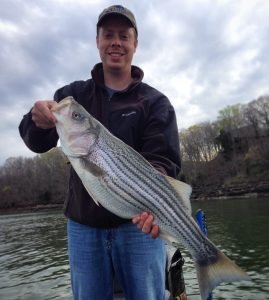Anglers with a bit of salt in their hair remember fondly the venerable Sassy Shad, the paddle-tailed, shad-shaped soft plastic wonder that caught practically anything that swims.
In the fishing lure world, what is old oftentimes becomes new again. Over the last decade or so, the soft-plastic swimbait stormed the fishing world, looking remarkably like a Sassy Shad with refinements.
With softer, lifelike soft plastic formulations and more realistic color schemes that closely resemble shad or other baitfish along with salt and scent fused into the lure, the modern swimbait is one of the most versatile lures you can throw.

Photo: Kentucky Department Fish and Wildlife
“Anything looking to eat a baitfish will hit a swimbait,” said Chad Miles, host of the “Kentucky Afield” television show and swimbait expert. “I’ve caught everything from crappie to striped bass and all three species of black bass, smallmouths, largemouths and spotted bass on a swimbait.”
Spring through early summer is one of Miles’ favorite times to fish a swimbait for black bass. He had a great trip on Lake Cumberland last spring while filming an episode of “Kentucky Afield.” They caught several quality smallmouth bass, largemouth bass in the 5-pound range and Executive Producer Nathan Brooks caught a 37-inch striped bass.
A 4-inch white and silver swimbait rigged on a 3/8-ounce leadhead fooled them all. They caught most of their fish on secondary points in Difficulty and Harmon creeks.
“The fish are up shallow at this time of year,” he explained. “I downsize the weight of the leadhead to a 1/4-ounce and use no heavier than 3/8-ounce. You do not make a big splash on the cast with a lighter leadhead. It also allows you to keep the lure from getting hung on the bottom.”
Employ a steady retrieve and work a swimbait down sloping banks that fall off into deep water or across points in spring through early summer. These areas draw shad and other baitfish, what the swimbait emulates.
“The good thing about a swimbait is you can adjust your depth and speed, which you really can’t do with a crankbait,” Miles explained. “It is all about getting the right speed on the retrieve and adjusting it according to the aggressiveness of the fish.”
On deeper lakes, such as Dale Hollow, Lake Cumberland and Laurel River Lake, Miles used a nose-weighted swimbait hook and a solid body swimbait for bass. He rigs these swimbaits hook exposed, the way most anglers used to rig a Sassy Shad.
“I use the belly-weighted wide gap swimbait hook and a hollow body swimbait for shallow lakes with more cover such as Kentucky Lake or Lake Barkley,” Miles said. “This setup is weedless and works great over weedbeds or through cover for bass.”
In clear water, the natural shad color is hard to beat for swimbaits. White with silver flakes is also a good color. “In stained water, I like swimbaits with some chartreuse or orange in them,” Miles said. “In murky to muddy water, I don’t throw a swimbait. They are other lures much more effective than a swimbait in those conditions.”
Miles said resisting the temptation to set the hook when you first feel a bite is the most important aspect of fishing a swimbait. “Keep reeling through the strike and let the rod load up a bit before setting the hook,” he said. “If you set the hook immediately, you are pulling the swimbait away from the fish.”
A medium to medium-heavy power fast action baitcasting outfit spooled with 10- to 12-pound fluorocarbon line works well for handling swimbaits.
“You are throwing a good amount of weight with a swimbait,” Miles said. “You need a rod that can handle it.”
As the days lengthen and the water warms, Miles works 5- to 6-inch swimbaits over channel breaks, ledges and submerged humps just above the thermocline for big largemouth bass on Kentucky Lake and Nolin River Lake.
“The swimbait works well in summer for suspended bass that are hard to catch on anything else,” Miles said. He counts the swimbait down in the water column over likely fish holding structures such as ledges, humps or points that extend out into the lake. He retrieves his swimbait deeper on each cast until he finds fish.
In summer, anglers on lakes with flooded timber such as Lincoln County’s Cedar Creek Lake do well working swimbaits slow and deep for largemouth bass suspended in the flooded timber.
After the weather turns cold in fall, Miles falls back to fishing 3-inch swimbaits in the natural shad color for smallmouth and spotted bass.
You can watch Miles employ his excellent swimbait techniques on a productive spring day on Lake Cumberland from a segment filmed last April by clicking on the KY Afield tab at the top of the Kentucky Fish and Wildlife homepage at www.fw.ky.gov. Once on the “KY Afield” page, click on the link “Visit our Youtube channel,” then type “Fishing with Swimbaits on Lake Cumberland” in the search bar.
 Weather
Weather Traffic
Traffic @LouisvilleDispatch
@LouisvilleDispatch @LouisvilleDisp
@LouisvilleDisp Subscribe
Subscribe

Leave a Reply